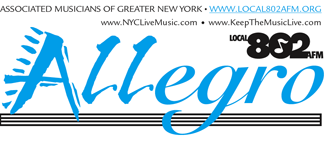
UNTANGLING THE WEB
How to Create a Web Site that Works
As printed in ALLEGRO
NOVEMBER, 2002
By KATHY CANFIELD with JUDE JUSSIM
It's everywhere. In CD ads, club listings, tour publicity - the ubiquitous "www" has permeated music marketing. If you don't have a web site now, you lose credibility, bookings, sales and audience. Today, a striking web presence is at least as critical to successful marketing as mailings and print advertising.
Is a web site right for you? If you are a freelance musician hoping to contact orchestra contractors, those contractors probably won't look online to find you. In contrast, if you are marketing to the public in any way, the answer is almost certainly yes. If you run a small chamber ensemble, a web site is an ideal tool for posting a concert schedule, selling tickets, increasing press coverage and building your concert audience.
How do you put together an effective web presence?
First, consider what you want the site to do for you. What audience do you want to reach and how do you want them to interact with the site? Will it simply be a promotional tool, or do you want to sell tickets or CDs? If your music appeals to a specific community where English is not the primary language, perhaps you will need your site translated. Do you want the site to serve as a reference to your repertory, and if so, will it need to be integrated with a database?
Your site content and design should interrelate, and are equally important. People are hit with visual imagery everywhere, and a strong, consistent identity helps make you visible among the noise. A good logo and related copy themes tell your audience something about who you are, and distinguish you from the competition.
Writing web copy is its own craft. Your existing printed materials are likely to need a makeover, with short, lively sentences and paragraphs, and pages planned to keep scrolling to a minimum. Make sure the copy is clean - grammatical howlers have the same impact as missed accidentals. Material should be organized for easy navigation. If your audience can't find where the fall schedule is hidden, the site is not doing you much good. The bottom line: use a professional copywriter. The investment is worth it - your web site is your full-time face to the world.
It's natural to think in terms of "cool" features, but they are not always appropriate. If your audience wants quick information (like a concert starting time) they will be frustrated at having to sit through an animation first. Consider how your viewers connect to the Internet. Bandwidth-hogging features like animation - or even too many photographs and complex graphics - can really slow response time for dial-up users. Research shows that viewers will wait only seconds before moving on to another site.
Be sure that both written and graphic content on your site is consistent with all copyright laws, and include your copyright notice. If you are going to gather information from visitors to your site (via an email sign-up form, for example) you should also include a privacy policy which states how this gathered information will be used.
A web site for the music business - like any business - is not a do-it-yourself project. People are used to seeing professionally-designed sites. While there are many tools available that allow anyone to build a web site, these tools are best used for family and personal sites. Just as a symphony orchestra hires highly trained musicians, so you should use a highly qualified designer.
How do you choose an appropriate designer? Look at web sites you admire within your industry and contact their designers. Ask colleagues who have web sites for their recommendations.
After you narrow down your search to a pool of designers, thoroughly review their portfolios. Are their sites visually stimulating? Easy to navigate? Quick to download? Can they help you find a copywriter and coordinate the process with them? If you don't have an established brand, logo or look, can they create one? If you do have one, will they be able to effectively incorporate that into your site? Check references to be sure you will be comfortable with their working process. Will they be responsive to your questions and concerns, and listen to your design preferences? Find out whether they bring projects in on time and within budget. Make sure they are prepared to help you with domain name registration and hosting company selection, if needed. Be sure you and your chosen designer work under a formal signed contract which states all that the designer will deliver as well as what will be expected of you.
Your site should be designed for maintenance. Consider the skills of the individual who will be maintaining your site in selecting design approaches and programming. Whether your webmaster is your designer, one of your staff or a third party, this kind of planning will facilitate efficient site updates and ensure the continued integrity of the site's design.
After you've launched, keep your site up-to-date. It's critical to the success of your site. You can destroy your investment in an award-winning web site by neglecting it. The internet allows people to get the most current information on any topic at any time. If your site still lists your 1999-2000 concert season, visitors will assume it's been abandoned. Even changing your home page several times a month with rotating bits of information will encourage visitors to come back.
Your web site is a crucial tool for success - when people know it's there. Don't expect search engines (e.g. Google) to do too much in bringing people to your site, unless you are prepared to invest a lot of time and money. You can market your web site through announcements to your mailing list and press releases. Arrange reciprocal links between your site and those of related organizations. Most important, make sure your URL is on all your printed materials and every e-mail you send out.
A web site is never "done." Features and organization change with your needs, and those of your audience. Ask your users for feedback, and let what you hear guide the evolution of your site. You will have a vibrant, practical site that people enjoy visiting - a web site that works.
Kathy Canfield is President and Founder of Canfield Design Studios, Inc. (www.canfielddesignstudios.com), a Web design and development company that helps arts organizations, nonprofits and small businesses achieve success. She is a member of Local 802 and plays French Horn for the Broadway production of Les Misérables.
Jude Jussim's Writing Services helps clients market themselves and their organizations through the written word in all its forms (www.jussim.com).
